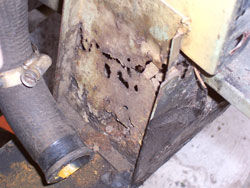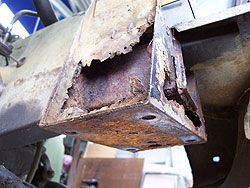





Bottom corners of the front & rear windscreen -
The bottom corners of the front & rear windscreens form a natural low spot in the windscreen opening, and I suspect retain moisture. The windscreen frame can rust through here but unfortunately you'll never know while the windscreen is in place. Tell tale signs are small rust blisters around this area.

Fuel Tank - Wagons - Perished tailgate or side window seals can result in rain entering the cavitiy under the rear cargo area of Station Wagons, resulting in water pooling around the base of the petrol tank. While a very generous coating of factory applied body deadener ensures the water has almost no effect on the car body, a felt packing strip running along the bottom of the petrol tank can soak up the water and keep the underside of the tank damp resulting in the petrol tank rusting through.
Article written by: Eriks Skinkis



Mobirise.com